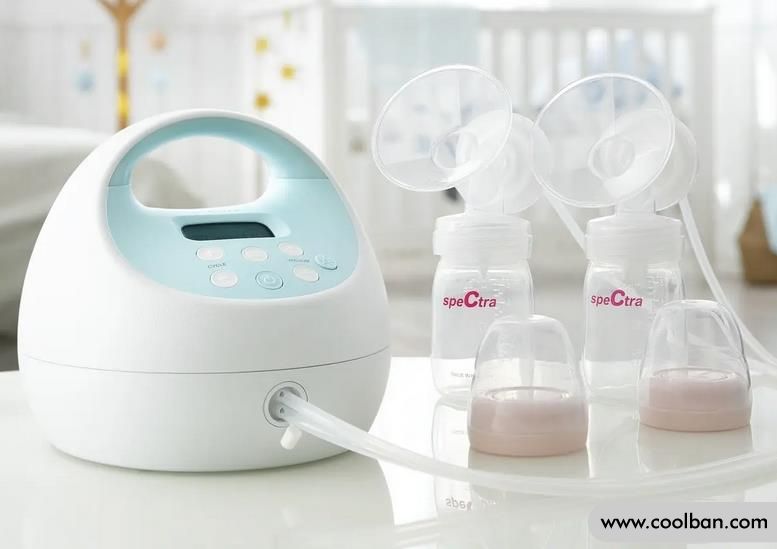How to deal with postpartum milk growth and how to prevent it
2022-03-24
For most new mothers, postpartum breastfeeding is a relatively common occurrence. Although it is said that postpartum milk growth is not that serious, if it is not handled properly, it will still cause serious consequences, not only feeling uncomfortable, but also possibly mastitis. If you notice that your milk supply has increased, new mothers should quickly adjust themselves. A new mother's body also undergoes a series of changes after giving birth. Is postpartum breastfeeding pain normal? How to relieve postpartum breast milk? Let's take a look together.

What should new mothers do if they increase milk after giving birth?
1. Correct posture reduces the burden on the breasts. It is also important to protect the breasts during this period. The wrong breastfeeding position can lead to insufficient milk supply, sore nipples, blocked milk, stunted baby growth, etc., so it is also important to master the correct breastfeeding position. When breastfeeding, the mother should keep the baby's head and body in a straight line, with the body facing the mother and the face facing the breast, while the mother maintains a comfortable position and the baby's body is close to her. In addition, the correct breastfeeding method should be the baby's lower lip everted, not adducted.
To make breastfeeding more comfortable, mothers can use a chair with armrests or choose a special nursing pillow.
2. Start breastfeeding as soon as possible, and let the baby express breast milk as soon as possible. For children, breast milk is needed to grow up. After the baby is born, you should start sucking as soon as possible, about half an hour after birth, start breastfeeding, which is conducive to the secretion of milk. Allowing the baby to fully suck is one of the ways to relieve the mother's breast blockage, which is conducive to dredging the mammary ducts and making the milk secretion smoother. The baby is full and the mother's pain is lessened.
In addition, you can use a hot towel for a minute before feeding to relax your breasts and promote milk production.
3. Use a breast pump to pump out excess milk. If you have a large amount of milk, you can store it first. Mothers have a lot of milk. When the baby's appetite is very small, mothers should also expel the milk in time. You can use a breast pump to pump out excess milk, which can not only solve the troubles of breast pain, but also promote milk secretion. It is recommended that mothers choose an electric breast pump, which is more convenient and practical, and saves worry and effort.
Of course, after the milk is expressed, it can be stored for a rainy day.
4. Increase support and choose underwear correctly. The correct way of wearing underwear and suitable underwear are very important. After giving birth, choose a suitable nursing bra made of soft cotton. The design is relatively wide, which can support the swollen and sagging breasts, improve the blood circulation of the breasts, help keep the breast ducts unblocked, reduce siltation, and relieve pain. . But be careful not to choose underwear that is too tight, otherwise it will only inhibit milk secretion.
5. Appropriate cold compresses can solve the discomfort of rising milk. It is very important to make improvements to avoid the problem of increasing milk. If the baby has breast tenderness within a few days after birth, it is a physiological swelling, and you can apply cold compresses. In addition, if you want to solve the problem of breast enlargement, then after feeding, in the middle of two feedings, when the breast is sore and the baby is unwilling to suck, the cold compress will cool the breast and reduce the swelling. The cooling time varies from person to person.
6. Diet adjustment, avoid high-sugar and high-fat foods. For dietary problems, everyone should pay attention to prevention, especially postpartum new mothers, avoid excessive nutrition, and eat a light diet, but eat more high-fat, high-sugar, greasy, and irritating foods, and avoid milk that is too thick and secreted . Not conducive to discharge.

How to prevent postpartum milk increase?
1. Breastfeed according to the needs of mother and baby. Have a certain understanding of the amount of children. If the milk is swollen or if you don't breastfeed for a long time, the milk can easily build up and cause mastitis. Therefore, nursing mothers should breastfeed on demand and empty their breasts at any time.
2. Timely and correct treatment of breast swelling. When it first appeared, it needed improvement. Postpartum, 30 grams of orange core can be used, decoct in water, generally 2-3 doses can prevent milk stagnation.
3. Drain the accumulated milk and clear the mammary ducts. It should be noted that there are many ways to unclog and discharge milk, such as manual milking, breast pump (or breast pump) milking, needle massage to discharge milk, etc., but no matter which method is used, try to The accumulated milk is excreted. as much as possible. , to clear the mammary ducts.
4. Insist on breastfeeding, do not stop breastfeeding. Breastfeeding children is very important. Breast milk is the best natural nutrition for babies. Convenient, economical, nutritious and safe. It can also enhance the bond between mother and child.
5. Suck the breast on the uncomfortable side first. The baby is hungry, and the initial sucking force is relatively large. Therefore, when breastfeeding mothers with mastitis, they should let the baby suck the affected breast first, and try to let the baby suck the breast before switching to the other side, which is conducive to clearing the blockage. mammary ducts.
6. Timely treatment of chapped nipples. Pay attention to the problem of inflammation. When the nipple is chapped, bacteria can enter through the crack, causing mastitis.

How long can postpartum breast augmentation last?
The mother will enter the breastfeeding period after giving birth, usually 2-5 days after giving birth, and the breastfeeding time is about a week, which is also a reminder for the second stage of breastfeeding. As a result, colostrum is produced. This stage is the first stage of lactation, but within 30-40 hours postpartum, the mother's milk production begins to increase. This is the second stage of lactation, followed by the third stage of lactation.
Breastfeeding mothers should actively respond, and use a hot towel to relieve the symptoms of breast tenderness. The lump can also help unclog the breast, which can effectively relieve the patient's pain, thereby relieving the symptoms of breast enlargement.
You can also shower the breasts with hot water and perform a moderate massage, or shake the breasts from side to side, which can not only help the milk flow, but also unclog the breasts and relieve the patient's condition. If your breasts are too swollen and your baby can't finish eating, you can use a breast pump to pump milk out of your breasts, which can reduce lumps in your breasts.

Is postpartum breast tenderness normal?
Postpartum breast tenderness is normal. After having a baby, breast enlargement occurs, which is what most women experience. In many cases, the baby will express breast milk in time, which will not only unclog the mammary ducts, but also promote the secretion of milk. If you choose to breastfeed after giving birth, you may experience frequent abdominal bloating in the short term.
In addition to the above mentioned, you can also let the baby suck milk in time. You can also use a breast pump to express milk in time, which can also promote the secretion of female milk. However, when using the breast pump, the pressure and speed should be adjusted in time according to the actual situation. When breasts are swollen, it is more uncomfortable due to breast swelling and pain. This time can be relieved by proper massage. Wash your hands before massaging and clean your breasts properly, otherwise it is easy to cause infection. The force should be even, not random.

What should new mothers do if they increase milk after giving birth?
1. Correct posture reduces the burden on the breasts. It is also important to protect the breasts during this period. The wrong breastfeeding position can lead to insufficient milk supply, sore nipples, blocked milk, stunted baby growth, etc., so it is also important to master the correct breastfeeding position. When breastfeeding, the mother should keep the baby's head and body in a straight line, with the body facing the mother and the face facing the breast, while the mother maintains a comfortable position and the baby's body is close to her. In addition, the correct breastfeeding method should be the baby's lower lip everted, not adducted.
To make breastfeeding more comfortable, mothers can use a chair with armrests or choose a special nursing pillow.
2. Start breastfeeding as soon as possible, and let the baby express breast milk as soon as possible. For children, breast milk is needed to grow up. After the baby is born, you should start sucking as soon as possible, about half an hour after birth, start breastfeeding, which is conducive to the secretion of milk. Allowing the baby to fully suck is one of the ways to relieve the mother's breast blockage, which is conducive to dredging the mammary ducts and making the milk secretion smoother. The baby is full and the mother's pain is lessened.
In addition, you can use a hot towel for a minute before feeding to relax your breasts and promote milk production.
3. Use a breast pump to pump out excess milk. If you have a large amount of milk, you can store it first. Mothers have a lot of milk. When the baby's appetite is very small, mothers should also expel the milk in time. You can use a breast pump to pump out excess milk, which can not only solve the troubles of breast pain, but also promote milk secretion. It is recommended that mothers choose an electric breast pump, which is more convenient and practical, and saves worry and effort.
Of course, after the milk is expressed, it can be stored for a rainy day.
4. Increase support and choose underwear correctly. The correct way of wearing underwear and suitable underwear are very important. After giving birth, choose a suitable nursing bra made of soft cotton. The design is relatively wide, which can support the swollen and sagging breasts, improve the blood circulation of the breasts, help keep the breast ducts unblocked, reduce siltation, and relieve pain. . But be careful not to choose underwear that is too tight, otherwise it will only inhibit milk secretion.
5. Appropriate cold compresses can solve the discomfort of rising milk. It is very important to make improvements to avoid the problem of increasing milk. If the baby has breast tenderness within a few days after birth, it is a physiological swelling, and you can apply cold compresses. In addition, if you want to solve the problem of breast enlargement, then after feeding, in the middle of two feedings, when the breast is sore and the baby is unwilling to suck, the cold compress will cool the breast and reduce the swelling. The cooling time varies from person to person.
6. Diet adjustment, avoid high-sugar and high-fat foods. For dietary problems, everyone should pay attention to prevention, especially postpartum new mothers, avoid excessive nutrition, and eat a light diet, but eat more high-fat, high-sugar, greasy, and irritating foods, and avoid milk that is too thick and secreted . Not conducive to discharge.

How to prevent postpartum milk increase?
1. Breastfeed according to the needs of mother and baby. Have a certain understanding of the amount of children. If the milk is swollen or if you don't breastfeed for a long time, the milk can easily build up and cause mastitis. Therefore, nursing mothers should breastfeed on demand and empty their breasts at any time.
2. Timely and correct treatment of breast swelling. When it first appeared, it needed improvement. Postpartum, 30 grams of orange core can be used, decoct in water, generally 2-3 doses can prevent milk stagnation.
3. Drain the accumulated milk and clear the mammary ducts. It should be noted that there are many ways to unclog and discharge milk, such as manual milking, breast pump (or breast pump) milking, needle massage to discharge milk, etc., but no matter which method is used, try to The accumulated milk is excreted. as much as possible. , to clear the mammary ducts.
4. Insist on breastfeeding, do not stop breastfeeding. Breastfeeding children is very important. Breast milk is the best natural nutrition for babies. Convenient, economical, nutritious and safe. It can also enhance the bond between mother and child.
5. Suck the breast on the uncomfortable side first. The baby is hungry, and the initial sucking force is relatively large. Therefore, when breastfeeding mothers with mastitis, they should let the baby suck the affected breast first, and try to let the baby suck the breast before switching to the other side, which is conducive to clearing the blockage. mammary ducts.
6. Timely treatment of chapped nipples. Pay attention to the problem of inflammation. When the nipple is chapped, bacteria can enter through the crack, causing mastitis.

How long can postpartum breast augmentation last?
The mother will enter the breastfeeding period after giving birth, usually 2-5 days after giving birth, and the breastfeeding time is about a week, which is also a reminder for the second stage of breastfeeding. As a result, colostrum is produced. This stage is the first stage of lactation, but within 30-40 hours postpartum, the mother's milk production begins to increase. This is the second stage of lactation, followed by the third stage of lactation.
Breastfeeding mothers should actively respond, and use a hot towel to relieve the symptoms of breast tenderness. The lump can also help unclog the breast, which can effectively relieve the patient's pain, thereby relieving the symptoms of breast enlargement.
You can also shower the breasts with hot water and perform a moderate massage, or shake the breasts from side to side, which can not only help the milk flow, but also unclog the breasts and relieve the patient's condition. If your breasts are too swollen and your baby can't finish eating, you can use a breast pump to pump milk out of your breasts, which can reduce lumps in your breasts.

Is postpartum breast tenderness normal?
Postpartum breast tenderness is normal. After having a baby, breast enlargement occurs, which is what most women experience. In many cases, the baby will express breast milk in time, which will not only unclog the mammary ducts, but also promote the secretion of milk. If you choose to breastfeed after giving birth, you may experience frequent abdominal bloating in the short term.
In addition to the above mentioned, you can also let the baby suck milk in time. You can also use a breast pump to express milk in time, which can also promote the secretion of female milk. However, when using the breast pump, the pressure and speed should be adjusted in time according to the actual situation. When breasts are swollen, it is more uncomfortable due to breast swelling and pain. This time can be relieved by proper massage. Wash your hands before massaging and clean your breasts properly, otherwise it is easy to cause infection. The force should be even, not random.
